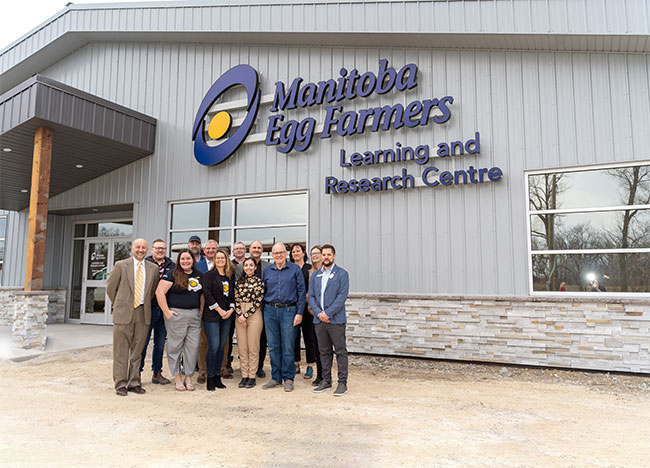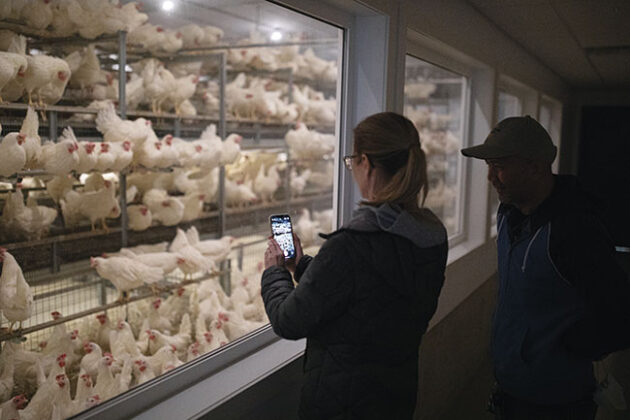
A new science frontier
By Madeleine Baerg
Features ResearchManitoba's egg sector recently unveiled an innovative new layer research and public engagement barn. Here's a closer look at the cutting-edge facility.
 Manitoba Egg Farmers has officially handed the keys for Canada’s newest poultry research and education centre to the University of Manitoba.
Photo: Manitoba Egg Farmers
Manitoba Egg Farmers has officially handed the keys for Canada’s newest poultry research and education centre to the University of Manitoba.
Photo: Manitoba Egg Farmers On April 26th, Manitoba Egg Farmers (MEF) officially handed the keys for Canada’s newest poultry research and education centre to the University of Manitoba (U of M). The Manitoba Egg Farmers’ Learning and Research Centre, co-financed by MEF and the governments of Canada and Manitoba, is the most modern egg and layer research, education and training facility in all of Canada. It’s also the only one purpose-designed to conduct cutting-edge research while also engaging and informing the general public.
Public front and centre
The facility features two housing systems: one a free-run aviary and the other equipped with enriched colony housing. Each is designed to run exactly how commercial barns operate around Manitoba.
Unlike commercial barns, the facility is built with the public in mind. Large windows allow visitors direct views into all parts of both housing systems. Additional windows showcase the movement of eggs from nests through the conveyor belt system to the egg packing facility and onwards to the refrigeration room.
“We wanted to be able to provide a place where folks can see exactly what we do on our egg farms. As far as the stocking density, housing systems, day-to-day chores, the regulations that we follow as egg farmers, we’re not doing anything different in this new building than we’d do on-farm. We’re really just showing what we do on farm, but in a biosecure way,” says Catherine Kroeker-Klassen, MEF’s board chair.
The new facility has pubic access components because it’s not just innovation and training the industry requires, it’s also the public’s trust, says Dr. Nazim Cicek, associate dean of research at the U of M.
“We need the public to understand where food comes from, how safely it is produced in Canada, what the latest practices are. There’s nothing like seeing, feeling, smelling the place to get you there. We can’t just talk about these things in the press or on TV: we need an open-door policy.”
Trained staff are available to talk people through the production process.
“I often hear people say, ‘Sorry, this is a dumb question’. There are no dumb questions. If you want to know about what we do, we want to answer. This barn allows us to do that,” says Kurt Siemens, a board director with MEF and an instrumental part of the new facility’s planning and building. “A lot of times, just seeing it isn’t enough. You need to know what the birds are doing and why.”
The new layer barn is in good company. It is the newest addition to the Bruce D. Campbell Farm and Food Discovery Centre: a learning centre for all ages that also features a working hog barn, the Dairy Farmers of Manitoba Discovery and Learning Complex, and a wide variety of hands-on interpretive exhibits.
Cutting-edge research capacity
The building is also purpose-built for cutting-edge research. Each housing system can be divided into smaller mini systems for replicated trials: the enriched housing divides into three rows of 108 units; the aviary into two rows of four sections per row.
Well-equipped research space in non-public portions of the building allow university students to learn about eggs and chickens, and scientists to explore different facets of production, from animal health and well-being, to egg quality, to production efficiency and more.
The space also features three controlled environment research rooms, egg quality and post-mortem laboratories, staff and student areas, meeting spaces and a feed storage kitchen where researchers can design customized feed for delivery to the metabolic rooms.
“We can look at no antibiotic alternatives, at novel feed products, at adding specific enzymes, all of which was hard to do in aging facilities with a lack of controls,” Cicek says.
In addition, the new facility is much better instrumented, from climate and care controls to power-failure backups.
“I’m sure there’s quite a few miles of wire in there just for internet alone. There’s a controller system that can be run remotely, so the barn can be run off an iPhone. It’s got its own generator: if there’s a power failure, it’s all powered back up again within two or three seconds,” Siemens says.
“It’s very exciting. Now we’ll be able to combine all of that data and provide existing and future farmers with information for real time decision making to allow them to be more profitable, more sustainable and better stewards of their animals,” Cicek says.
In the near term, most of the research undertaken at the new facility will be continuations of the work that was underway at the previous location. However, the new facility’s state-of-the-art equipment will allow scientists research opportunities they couldn’t have pursued previously.
With luck, the new facility will help the U of M retain existing research talent and draw additional high-caliber expertise. Cicek says the school already boasts excellent animal science researchers who will take great advantage of the new facility.
Already, the university has hired several new staff, including digital agriculture researcher who began work this past March. In addition, the U of M is hoping to leverage the new Layer Research Barn to attract a poultry-specific research chair to advance the sector.
“There already exist research chairs in different parts of the country in different universities, but we don’t have one [for poultry] at the U of M. Now is the time to leverage the new infrastructure by bringing in world class talent. You really can’t do that if you’re touring them in facilities from the ‘60s or ‘70s. You do need new infrastructure to bring in the best minds,” he says.

Large windows allow visitors direct views into all parts of both housing systems.
Photo: Manitoba Egg Farmers
A group effort
The MEF Learning and Research Centre project came together thanks to the efforts of many. U of M provided the land, MEF and the U of M designed the facility, and MEF managed the actual build.
The project’s $4 million price tag was partially funded through a $1.5 million contribution from the governments of Canada and Manitoba through the Canadian Agricultural Partnership (CAP) fund. The remainder of funds – over $2 million – came from Manitoba egg farmers.
“We found a neat win-win-win way of funding where we allowed our farmers to [buy quota] for a couple of extra birds in their barn. Then, we used that money to fund the facility,” Siemens says. “Farmers really jumped at the opportunity. The turnaround on it was very quick: within about a week we had all 6,000 [quota units] sold at [a maximum of] 55 birds [per producer]. With the money going to such a great project, you can hardly say no.”
Siemens says the whole MEF board is incredibly grateful for producers’ support.
“I think the most important message is to thank Manitoba producers for their backing. Not a single person said, ‘Oh, that’s a crazy idea’ or ‘That’s way too much money’. They saw the value and they contributed.”
On Grand Opening day, MEF officially handed operations of the building to a “very appreciative” U of M, Cicek says.
“None of this happens without the close connection between our stakeholders. We want to acknowledge all of them. That’s really the model for agriculture. If you want to achieve new heights, we need to work together.”
A well-needed upgrade
The new facility replaces the University of Manitoba’s older egg laying research facility at the Fort Garry campus.
“It was still doing its job for the most part, but it was old, and it certainly wasn’t helping as far as recruiting new students or researchers, and it wasn’t even conducive to doing really great research. So that was part of the push,” Klassen says.
“Not to mention, the great big new Winnipeg Blue Bombers and the University of Manitoba Bison football team stadium was built not farm from the old barn, so every time something amazing happened over at the football stadium, those poor birds got scared, which wasn’t great for the research side of things.”
Direct benefits for farmers
Cicek is confident that individual egg farmers will see direct benefit from research done at the new facility. The close relationship between Manitoba Egg Farmers and the university will enable the scientists to ensure research priorities align with industry’s priorities.
Additionally, he encourages farmers to attend and engage with the facility’s researchers and staff during the regular tours, meetings, and stakeholder engagement opportunities that will be hosted at the new barn.
“The whole intention of having MEF closely involved in the design of this facility is to then allow their members to benefit most from it. Otherwise, we would have just built a research facility. But that’s not what this is. This is a research, public engagement and stakeholder facility,” he says.
As a parent and a farmer herself, Klassen says the barn offers important industry benefits for the next generation too.
“I’m a fourth-generation farmer. My brother and I farm together not far from the new research centre. We’ve both got kids who are interested in being farmers when they grow up. We want to be able to offer that to them. We don’t want to be in a dying industry. This [facility] is a great legacy that will help our kids have opportunities in this industry.”
And now, the real work begins
The facility’s first round of birds arrived in March. For the first few months, the facility staff will ensure both the aviary and enriched housing areas run to commercial standards before research begins.
Hiring research staff and graduate students to conduct the day-to-day testing will also take some time. However, Cicek says researchers are “chomping at the bit” to get in and start working.
“Everybody walked away from [the grand opening] with a sense of optimism and joy and excitement. We don’t want to lose that momentum. Our goal now is to follow up on that.”
By the numbers
Here are some quick facts about the Manitoba Egg Farmers’ Learning and Research Centre.
- 22,000 is the square footage of the new facility.
- 4,400 is the amount of quota the centre has, which includes 2,200 in enriched housing and an equal amount in a free-run system.
- May 1st, 2023 is the day the research facility opened to the public.
- 9,000 is the approximate number of people expected to visit the research centre annually.
- 16 is the number of faculty who will be working in the facility to start.
- $300K is the facility’s annual operating budget, which will be paid by the university.
Print this page